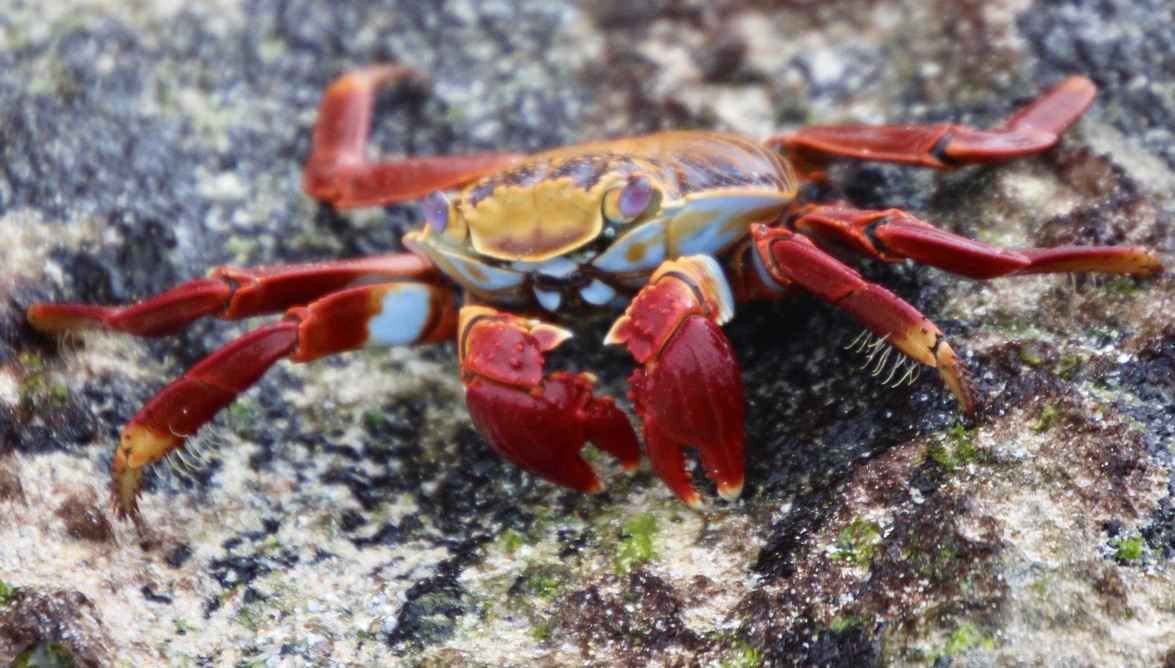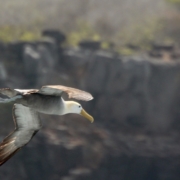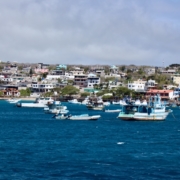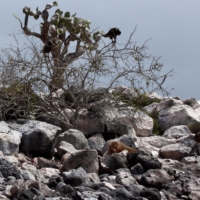Photos Drífa Freysdóttir
Third day
Isla Floreana
https://en.wikipedia.org/wiki/Floreana_Island
Despite the population size the early thirties in Floreana was a place for a mystery drama. https://www.thoughtco.com/unsolved-murder-mystery-the-galapagos-affair-2136125
Punta Cormorant was our first destination. There is a brackish lagoon there with a Flamengo sighting possibility. Two coves are accessible on each side of the Punta with a short hike through the Palo Santo forest. The Palo Santo trees were bare, waiting for the rainy season. We were lucky with our sightings – flamingos – green turtle – nursing sea lion – penguin – plus the usual suspects! We sure ticked all the boxes for that location.

We spotted a Green turtle ambling up onto the beach. The turtle will crawl above the high-water mark and dig a hole there whereupon the eggs are deposited. The eggs are covered with sand and the turtle makes its way to the ocean again. Curiously the sex of the turtle is temperature dependent – over 31 centigrade in the nest will produce females – under 28 Centigrade males and in between a mix. I have seen news that there are now more female turtles hatched. https://oceanservice.noaa.gov/facts/temperature-dependent.html

On the brackish lake there were indeed flamingos snacking with their heads upside down finding their food in the mud. The Palo Santo trees are waiting for the rains to start. The hillside will turn green and conditions will become more tropical. https://animalcorner.co.uk/animals/galapagos-flamingo/

Palo Santo waiting for the rain 
Flamingos
On our way to the ship we had a stroke of luck and spotted a Galapagos penguin. This little guy was cleaning up on a lava outcropping and our guide spotted him. The Galapagos Penguin is of the banded variety (relatives in Patagonia and South Africa), and the only penguin to venture north of the equator.

From Punta Cormorant we sailed to Corona Diablo, that is a volcanic crater half submerged. This turned out to be a fantastic snorkeling experience. However, my skills at shooting underwater photos is limited, but the wet suit sure is dressy.

School of fish 
It was cold!
On to Post Office Bay. Whalers started the tradition of leaving letters in a barrel in Post Office Bay. When it was time to return home they stopped by the collective post office and took letters heading for the same destination and hand delivered them to the addressees. – https://www.galapagosislands.com/blog/post-office-bay/

The post office 
The post master?
The usual suspects.

Blue footed booby
Darwin finch 
Ruddy turnstone (Ísl. Tildra) 
Brown pelican (juvenile) 
Red rock crab 
Sanderling
The Mangroves are vital for coastline ecology. This tree has adapted to saline environment and excretes salt on the underside of their leaves. If you do not believe me lick a mangrove leaf. Their importance will increase with rising sea levels. Let’s hope this shoot will make it. https://en.wikipedia.org/wiki/Mangrove

Next stop Isla Santa Fe.









Thanks Mike for this info. We neither went to Pinta nor Santa Cruz where Lonesome Georg lives his afterlife stuffed in Darwins research station. I plan to visit again to see some more islands and I will make a point of checking him out.
No mention of Lonesome George?Poor old George was the last of the Pinta Island species of giant tortoises who spent his last years trying to mate with the other types of Giant Tortoises but with no luck – I managed to see him before he popped his clogs in 2012